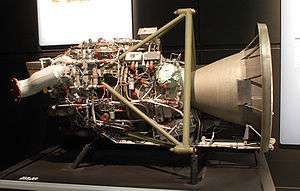Reaction Motors XLR99
| XLR99 | |
|---|---|
 | |
| The XLR-99 engine. | |
| Type | Liquid-propellant rocket engine |
| National origin | United States |
| Manufacturer | Reaction Motors |
| Major applications | North American X-15 |
The Reaction Motors XLR99 engine was the first large, throttleable, restartable liquid-propellant rocket engine. Development began in the 1950s by the Reaction Motors Division of Thiokol Chemical Company to power the North American X-15 hypersonic research aircraft. It could deliver up to 57,000 pounds force (254 kN) of thrust with an Isp of 279 seconds (239 seconds sl). Thrust was variable from 50 to 100 percent, and the restart capability allowed it to be shut down and restarted during flight when necessary.
Design and development
The engine is propelled by liquid oxygen and anhydrous (water-free) ammonia, pumped into the engine by turbopumps at a mass flow rate of over 10,000 lbs (4,500 kg) per minute.
After one hour of operation, the XLR99 required an overhaul. Operating times nearly twice that were recorded in tests, but declared largely unsafe. The basic X-15 aircraft carried fuel for about 83 seconds of full-powered flight, while the X-15A-2 carried fuel for just over 150 seconds. Therefore, each XLR99 was capable, in theory, of between 20 and 40 flights before an overhaul.
Like many other liquid-fuel rocket engines, the XLR99s used regenerative cooling, in that the thrust chamber and nozzle had tubing surrounding it, through which the propellant and oxidizer passed before being burned. This kept the engine cool, and preheated the fuel. The basic engine weighs 910 lb, or 413 kg.
Operational history
The XLR-99 was used exclusively to power the X-15 research aircraft after initial trials that used a pair of Reaction Motors XLR11s.
Applications
Specifications
Data from:Aircraft engines of the World 1959/60[1]
General characteristics
- Type: Liquid-fuelled rocket engine
- Length:
- Diameter:
- Dry weight:
- Fuel: Liquid Ammonia (NH3)
- Oxidiser: Liquid Oxygen (LO2 / LOX)
Components
- Pumps: turbopumps <10,000 lb/min driven by decomposed Hydrogen Peroxide H2O2
Performance
- Thrust: 50,000 lbf (222.41 kN)
- Burn time:
See also
References
- ↑ Wilkinson, Paul H. (1959). Aircraft engines of the World 1959/60 (15th ed.). London: Sir Isaac Pitman & Sons Ltd. p. 40.
External links
- Reaction Motors XLR99 Rocket – National Museum of the United States Air Force
- XLR-99